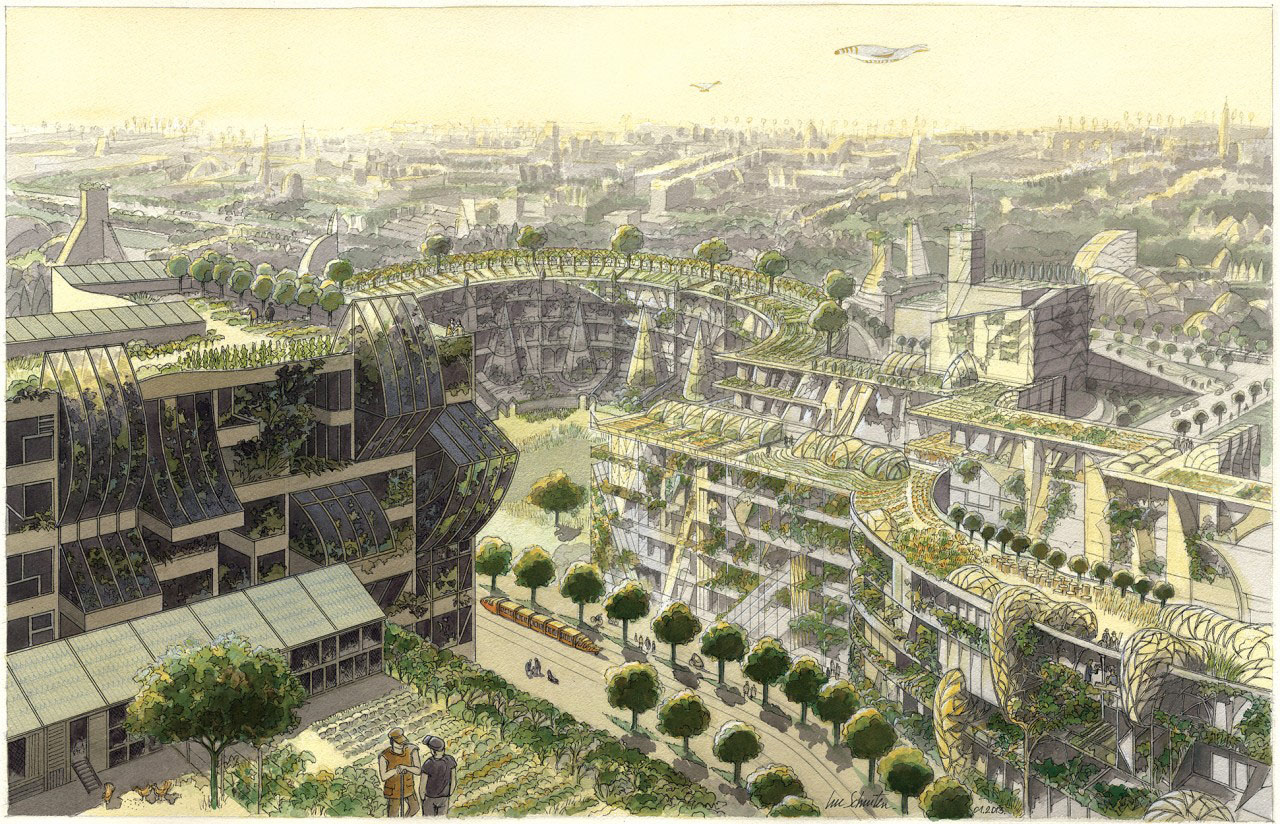
September 27, 2021 / Leave a comment
A delicious immersion in the fantastic dream world of Luc Schuiten.
I had the huge honour on Thursday morning to spent over two hours with the amazing architect and artist Luc Schuiten. Luc is an architect who designs extraordinary ecological buildings and who also has become very well known, mostly in the French-speaking world, for his incredible images showing what an ecological, regenerative future could look like in about 100 years.
The meeting came about because after my talk at Louvain-le-Neuve on Tuesday evening, as we left the main hall at the university there, I was really taken with an incredible mural of one of his images and took lots of photos of it. I hadn’t heard of his work before, but a friend knew someone who knew him, and so, two days later, I’m standing, with my friend Josué Dusoulier, Josue’s young son Marc, and Beniot, on a rather grand old street in Brussels, outside a tall elegant house typical of the smarter districts of the city.
On the opposite side of the road is a large, sun-filled, circular park, the first hints of autumn beginning to appear among its many mature trees, one woman brushes her dog who appears to live for the experience.
The door opens, and we’re met by Luc, who invites us into the beautiful large room of his house which is home to his architectural practice. The walls are lined with books, and with large prints of his drawings. It’s a beautiful sunlit space. He’s as thrilled to meet us as we are to meet him.

His drawings are extraordinary. They try to represent what our towns and cities could look like in 2100 if they were the result of a process of being transformed into what he calls ‘vegetal cities’, living, regenerative places shaped by biomimicry, the shapes and patterns of nature, and by a society more rooted in kindness, care and equality than the one we live in today.
He is not constrained by the building materials available to architects in 2021, rather allowing himself to imagine that by then we are building homes from mushroom-based materials and a wide range of other flexible, durable and sustainable materials that haven’t been invented yet (plus some that have).

Luc greets us with a glee and a delight that reminds me a little of Willy Wonka in Roald Dahl’s book ‘Charlie and the Chocolate Factory’. He is vivacious, with bright eyes, and an immense curiosity. He talks us through his drawings and we are straight into a deep and rich conversation about his work.
After a while, he stands up and ushers us through into the rest of his house. I think the prompt was my asking him how he sustains and nurtures his imagination in a world that is so ruinous to most peoples’ attempts to live imaginative lives. He takes us to his bathroom to show us his bath.

It is the first bath I’ve ever seen that’s made from wood, and is modelled, he tells us, on the contours of him and his wife so they can lie side by side (“it’s where we have our best conversations” he tells me). When the taps are turned on, the water runs down a little channel, like a river, round one side of the main tub.
He then leads us down into a corridor in the depths of the house to show us his ‘car’. It is a hybrid pedal-powered/ electric vehicle with two seats. It’s an amazing thing. The only problem with it, he explains, is that no-one can hear it coming. So instead of a horn, it has a series of loud samples: a horse neighing, an old fashioned train sounding its horn, a dog barking. It’s hilarious. I feel like a more benign version of Bruce Wayne is showing me his Batmobile in the Batcave. Only with lower emissions.

Then he takes us out into the garden. For a house in the centre of the city, the garden is surprisingly large and is home to some beautiful mature trees. From one of those trees, a stunning acacia with bright green leaves, hangs a seat, suspended by ropes and pulleys.

He explains how he sits in this seat, and attaches to his head a device that measures, I am imagining, the electrical pulses from his brain, pulses that change when one meditates. As he sits and meditates, his detectable brainwaves change, which prompts the chair to be slowly lifted up into the higher branches of the tree. It is when we is sitting, in a mildly meditative state, high among the leaves of the tree, looking out through the leaves across the city, that his best ideas come to him he tells me. His work all of a sudden makes perfect sense.

I did an interview with him which I’ll share with you in due course, but for now I just wanted to leave you with the image of a meditative person, high in a tree looking out across the city, through the early autumn leaves, and how central that change of perspective is to his being able to think so lucidly about a different future. Perhaps all the politicians already conceding the COP26 will fail to achieve all that it needs to should be invited around to take a ride to the treetop in Luc’s mediation seat. Who knows what it might unlock?
Comments